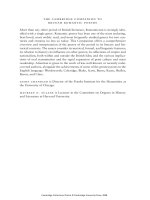The cambridge companion to british roman 58
Bạn đang xem bản rút gọn của tài liệu. Xem và tải ngay bản đầy đủ của tài liệu tại đây (38.69 KB, 1 trang )
n i c k g ro o m
Had poetry lost its way, becoming opaque or simply irrelevant to the
“common readers of poetry,” separated from humanity and the humanities?
The clue is in Peacock’s contrast of barbarity with the “civilized community.” His template for this thinking is in the tension between the classical
and the Gothic, the civilized and the savage, and the larger question of British
identity (here disparagingly referred to as “Cimmerian” – an ancient barbarian race thought to be a proto-Celtic or proto-Germanic tribe). Throughout
the discussions and deployments of antiquity during the period there is a
rumbling anxiety over national identity: what does it mean to be British?
The contrast between the classical taste and the Romantic or Gothic taste
had occupied critics for most of the eighteenth century – and continues to
exercise opinions. The pioneering literary antiquarian Thomas Warton, for
instance, had adapted his neoclassical training for the analysis and criticism
of indigenous British literature, first outlined in Observations on the “Fairy
Queen” of Spenser (1754) before being profoundly developed into an identifiable canon and recognizable national literary culture in his monumental
History of English Poetry (published from 1774). Very early in his career
Warton drafted possibly the first “Essay on Romantic Poetry” (1745), which
asserts that Romantic taste is “entirely different” from the classical because
it imitates “the actions of spir[i]ts, in describing imaginary Scenes, & making persons of abstracted things,” although it had “more Judgement and
less extravagance” than the writings of antiquity, by which Warton meant
principally medieval romances.5
Eighty years later, Hazlitt was paraphrasing the German writer A. W.
Schlegel on the same topic, identifying the classical with universal human
associations, and the Gothic with the individual imagination: “A Grecian
temple, for instance, is a classical object: it is beautiful in itself, and excites
immediate admiration. But the ruins of a Gothic castle have no beauty or
symmetry to attract the eye; and yet they excite a more powerful and Romantic interest from the ideas with which they are habitually associated.”6 And
yet the two styles are often less opposites in the aesthetics of the period
than different strands of antiquity twisted together. Percy Shelley’s famous
response to Peacock (his A Defence of Poetry, written in 1821) indicates as
much. In a sense, Shelley confirms Peacock’s criticisms by claiming that culture and hence artistic conception were accumulative and organic. Shelley
called for an acknowledgment of and responsiveness to the literature of earlier cultures, arguing that the poetry of chivalric society came into being only
after properly incorporating “the poetry and wisdom of antiquity,” which
he summed up as Platonism, Christianity, and Celtic mythology – in so doing
combining ancient Greece with ancient Britain. “The result,” he concluded,
“was a sum of the action and reaction of all the causes included in it.”7
36
Cambridge Collections Online © Cambridge University Press, 2008









